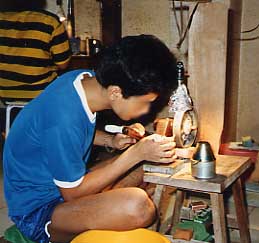Lapidary
Lapidary is the art and science of working with gemstones. It encompasses a wide range of activities, including cutting, polishing, and engraving stones. The primary goal of lapidary work is to enhance the natural beauty of the stones, making them suitable for use in jewelry, decorative items, and various art forms. This craft requires a deep understanding of the physical and optical properties of gemstones, as well as skilled craftsmanship.
History[edit | edit source]
The history of lapidary work dates back thousands of years, with evidence of gemstone cutting and polishing found in ancient civilizations such as Egypt, Mesopotamia, and Indus Valley. These early lapidaries were skilled artisans who used rudimentary tools to create beads, amulets, and seals. Over the centuries, the techniques and tools have evolved, leading to the sophisticated lapidary practices seen today.
Techniques[edit | edit source]
Lapidary involves several techniques, each suited to different types of stones and desired outcomes. The most common techniques include:
- Sawing: The process of cutting rough pieces of gemstones into manageable sizes using a lapidary saw.
- Grinding: The use of a grinding wheel to shape stones and remove excess material.
- Sanding: A finer form of grinding, sanding is used to smooth the stone's surface.
- Polishing: The final step, polishing gives the stone its shine and luster through the use of progressively finer abrasives.
Lapidary Equipment[edit | edit source]
The equipment used in lapidary work has evolved from simple hand tools to sophisticated machinery. Key pieces of equipment include:
- Lapidary Saws: Used to cut rough stones into slabs or preforms.
- Grinding Wheels: Essential for shaping and smoothing the stones.
- Polishing Machines: Used to achieve a high gloss finish on the stone.
- Dopping Tools: Tools used to hold the stone in place during cutting and polishing.
Gemstones[edit | edit source]
A wide variety of gemstones can be used in lapidary work, each with its own unique properties and challenges. Popular stones include quartz, agate, jade, turquoise, and diamond. The choice of stone depends on the desired aesthetic and physical properties, such as hardness, color, and transparency.
Applications[edit | edit source]
Lapidary work finds applications in several areas, including:
- Jewelry Making: Creating gemstones for use in rings, necklaces, earrings, and other pieces of jewelry.
- Decorative Arts: Crafting objects such as vases, bowls, and sculptures from gemstones.
- Collecting: Many people collect polished stones, faceted gems, or mineral specimens for their beauty and rarity.
Challenges and Considerations[edit | edit source]
Lapidary is a meticulous and time-consuming craft that requires patience and precision. One of the main challenges is the inherent variability in gemstones, including flaws and variations in hardness. Additionally, the process of cutting and polishing can be hazardous, requiring proper safety measures to avoid injury from sharp tools and toxic dust.
Conclusion[edit | edit source]
Lapidary is a fascinating and rewarding craft that combines artistry with a deep understanding of natural gemstones. Through the skilled hands of lapidaries, rough stones are transformed into beautiful gems that enhance all manner of decorative objects and jewelry, continuing a tradition that spans millennia.
This craft related article is a stub. You can help WikiMD by expanding it.
Navigation: Wellness - Encyclopedia - Health topics - Disease Index - Drugs - World Directory - Gray's Anatomy - Keto diet - Recipes
Search WikiMD
Ad.Tired of being Overweight? Try W8MD's physician weight loss program.
Semaglutide (Ozempic / Wegovy and Tirzepatide (Mounjaro) available.
Advertise on WikiMD
WikiMD is not a substitute for professional medical advice. See full disclaimer.
Credits:Most images are courtesy of Wikimedia commons, and templates Wikipedia, licensed under CC BY SA or similar.
Contributors: Prab R. Tumpati, MD




